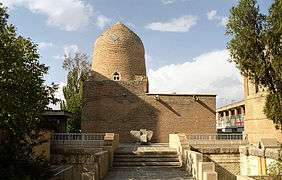Tomb of Esther and Mordechai
| Tomb of Esther and Mordechai | |
|---|---|
|
Native name Persian: بقعه استر و مردخای | |
|
Tomb of Esther and Mordechai | |
| Type | Mausoleum |
| Location | Hamadan, Iran |
The Tomb of Esther and Mordechai (Persian: بقعه استر و مردخای) is located in Hamadan, Iran. Believed by some to house the remains of the biblical Queen Esther and her uncle Mordechai, it is the most important pilgrimage site for Jews in the country.
Description
In 1891, the tomb was described as consisting of an outer and inner chamber surmounted by a dome about 50 feet (15 m) high. The dome had been covered with blue tiles, but most of them had fallen away. A few tombs of worthy Jewish individuals were located within the outer chamber.[1]
According to Stuart Brown, the site is more probably the sepulcher of Shushandukht, the Jewish consort of the Sasanian king Yazdegerd I (399–420 A.D.).[2]
Alternative location
Another tradition first recorded during the Middle Ages places the graves of Esther and Mordechai in the Galilean archaeological site of Kfar Bar'am, close to the kibbutz of the same name, Bar'am, along Israel's northern border with Lebanon.[3] [4]
Gallery
| Wikimedia Commons has media related to Tomb of Esther and Mordechai. |
 Eugène Flandin (1840)
Eugène Flandin (1840) Eugène Flandin (1840)
Eugène Flandin (1840) Interior (2008)
Interior (2008)
References
- ↑ Journeys in Persia and Kurdistan: Including a Summer in the Upper Kabun Region and a Visit to the Nestorian Rayahs, Mrs Bishop, 1891. pg. 133-134.
- ↑ Stuart Brown (1997). "Ecbatana". In Eric M. Meyers. The Oxford Encyclopedia of Archaeology in the Near East. 1. Oxford University Press. pp. 186–187.
- ↑ Michael Freund, Where is the Tomb of Mordechai and Esther?
- ↑ Home and Family: Who is Buried in Queen Esther's Tomb?, Dei'ah veDibur, February 28, 2001.
